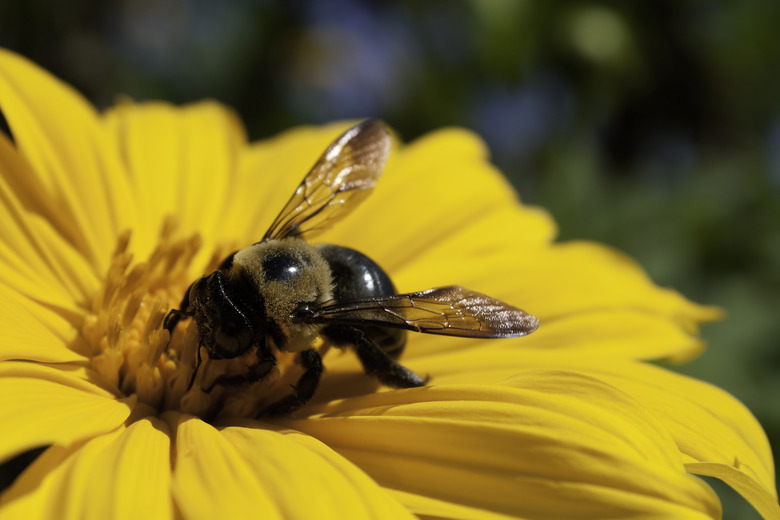How To Find A Carpenter Bee Nest
Carpenter bees, also known as wood bees, come in two varieties: the genus Xylocopa, or large carpenter bees, and the genus Ceratina, or small carpenter bees. A typical large carpenter bee is about the size of a bumblebee – about 12 to 25 mm long – and has many of the same markings. You can tell them apart because the bumblebee is hairier, especially in the abdomen area. A small carpenter bee is only about 8 mm long. Its dark color makes it easy to differentiate from other bees of similar size, such as honeybees.
Carpenter bees are solitary, and they don't create hives. Instead, the female burrows into wood to create chambers in which to lay her eggs. It isn't easy to find one of these burrows, but if you know where to look, there are two telltale signs to note. Persistence helps. The bees use the burrows over and over again, so if winter comes, and you haven't located the nest you're looking for, just wait until summer and try again.
Bees Nest in the Wood
Bees Nest in the Wood
Carpenter bees are boring bees, and not the type of boring you'd associate with your dad's jokes. The bees make nests by tunneling or burrowing into dry, pithy wood. They prefer large branches or dead trees, but they aren't averse to burrowing into an old, partially rotted fence post or a piece of trim on your house. The holes are about 1/2 inch in diameter, although they can be larger if the made by a large carpenter bee, and you might see more than one. The female bee, which is the one that does the boring, typically creates several burrows. She may create them side by side, or she might create a single long tunnel in which she can create partitions.
Once she has created the tunnels, the female deposits the eggs and leaves a supply of regurgitated pollen and nectar to nourish the larvae when they hatch. Shen then covers the tunnel opening with mud, which is the first telltale sign of a carpenter bees's nest. You'll find the mud-covered openings more often on the end grain of a piece of wood than on the face, because it's easier for the bees to burrow into end grain.
Let the Male Lead You
Let the Male Lead You
The male carpenter bee may look formidable, but he lacks a stinger and is completely harmless. The female can sting, but she will do so only if you try to grab her or similarly threaten her. The male bee is the one you'll most likely see, and he may be exhibiting what appears to be aggressive behavior. If so, it's because he's defending the nest, so keep an eye on him and he'll probably lead you to it. This protective activity is the second telltale sign of a nest. It may be in the eaves of your house, but it will more likely be in the yard somewhere. If you have an old pile of wood lying around, that's the best place to look.
The Young Bees Emerge in August
The Young Bees Emerge in August
The best time of year to look for a carpenter bee's nest is in August. That's when the fully developed juveniles emerge from the nests after hatching, pupating and maturing. After they emerge, the tunnel opening is exposed, which makes it easier to see. The bees will return to the same nest to hibernate for the winter, and a female may deposit more eggs, so if your intention is to cover the holes to encourage them to go elsewhere, it's best to do it in the late summer or early fall.
Cite This Article
MLA
Deziel, Chris. "How To Find A Carpenter Bee Nest" sciencing.com, https://www.sciencing.com/carpenter-bee-nest-5583265/. 22 November 2019.
APA
Deziel, Chris. (2019, November 22). How To Find A Carpenter Bee Nest. sciencing.com. Retrieved from https://www.sciencing.com/carpenter-bee-nest-5583265/
Chicago
Deziel, Chris. How To Find A Carpenter Bee Nest last modified March 24, 2022. https://www.sciencing.com/carpenter-bee-nest-5583265/
